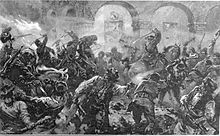1907 Romanian Peasants' Revolt
| 1907 Romanian peasants' revolt | |||||
|---|---|---|---|---|---|
 A cavalry patrol sabring the rioters in the streets of Comănești (Illustrated London News) |
|||||
|
|||||
| Belligerents | |||||
|
Disaffected peasants | ||||
| Commanders and leaders | |||||
|
Carol I Gheorghe Cantacuzino Dimitrie Sturdza Alexandru Averescu |
Unknown | ||||
| Casualties and losses | |||||
| Army: 10 killed, 4 wounded Unknown numbers of landowners and lessors killed or wounded |
419 (officially) to 11,000 (common estimate) killed 10,000 arrested |
||||
The 1907 Romanian Peasants' revolt took place between 21 February and 5 April 1907. It started in northern Moldavia and, after three weeks in which it was localized in that area, it quickly spread, reaching Wallachia, including as far as Oltenia. The main cause was discontent of the peasants about the inequity of land ownership, which was in the hands of just a few large landowners.
Following the fall of the Conservative Party government on March 12, the new Liberal government crushed the revolt violently with the help of the Romanian Army, killing thousands of peasants in the process.
The 1864 land reforms gave the peasants full ownership rights for part of the land for which they previously had only the right to use. However, the peasants remained even after these reforms dependent on the local landlords. Additionally, the peasant population was rising fast, leading to rapidly shrinking properties: from an average family property of 3.42 hectares in 1896 down to 3.27 ha in 1905 and 3.06 ha in 1907. The state was also a big landholder, however, its policies for selling the land often did not favor poorer peasants, who were in the greatest need for land.
Needing to supplement their shrinking properties, the peasants were forced to use land owned by the landlords, who owned large estates. As population grew, the peasants became more and more desperate for land, leading to rapidly rising rents. At that time, peasants formed up to 80% of the Romanian population and about 60% of them owned small crops, or no land at all, while the large landowners owned more than half of the arable land.
The National Liberal Party's policy to encourage peasant cooperatives was not successful, as many landlords feared the organization of the peasants, preferring to lease to individual peasants rather than to cooperatives. According to Ion Lahovari, the Conservative Minister of Domains, a landlord could drive out a peasant refusing to pay his rent, but noted that for driving out a cooperative of 500 peasants, a regiment would be needed and the government may refuse to put it at the landlord's disposal. As such, by the end of 1907, there were only 103 village cooperatives having a membership of 11,118 leasing 37,344 hectares, most of it leased from the state.
...
Wikipedia
